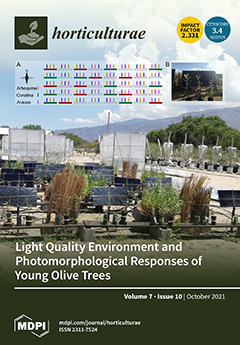(1) Background: This special issue contains new developments in the field of fresh produce quality. Freshness provides the appeal for the consumer to purchase a particular horticultural produce. Freshness is a combination of size, colour, shape, flesh firmness, turgescence and glossiness without wilting,
[...] Read more.
(1) Background: This special issue contains new developments in the field of fresh produce quality. Freshness provides the appeal for the consumer to purchase a particular horticultural produce. Freshness is a combination of size, colour, shape, flesh firmness, turgescence and glossiness without wilting, which imply that the produce has been picked only a short while ago and has not suffered any decay during harvest, transport or storage.
(2) Objective: The objective of the present work was to develop potential freshness indices. The indices are based on non-invasive, real-time measurements, using changes in surface appearance after harvest, using Bell pepper as the most difficult model.
(3) Methods: The selection criteria were a dramatic change in values over 14 days of storage at 17 °C, and either a consistent decrease or increase without peaks and troughs. Only two (out of five) non-invasive techniques were selected, i.e., surface glossiness, measured non-destructively using a luster sensor (type CZ-H72 from Keyence Co., Osaka, Japan) and light reflection spectra, recorded by a spectrometer, whereas the three techniques fruit firmness (penetrometer), colorimeter (e.g., Minolta) and false colour images (profilometer) were excluded.
(4) Results: The first technique based on fruit glossiness provides luster values depending on fruit colour. Green Bell pepper fruit with a Fresh Index in excess of 463–490 a.i. can be classified as fresh, and similarly of 525–565 a.i. for yellow and 486–502 a.i. for red pepper fruit. This first Freshness index dropped, indicating a lesser freshness, to less than 100 a.i. after 14 days storage, irrespective of fruit colour, thereby providing a suitable wide, ca. 5-fold, range of parameterization. The second index is based on the difference between the light reflectance peaks at 630–633 nm and at 500 nm, also measured perpendicular to the convex fruit side. These percentage values decreased from >40% with fresh red and yellow Bell pepper to ca. 20% after 14 days storage; similarly, these percentages decreased from ca. 16% to ca. 8% in green pepper fruit, in both cases by a twofold factor. Overall, a third Freshness index could be a combination of luster values larger than 470 a.u. and >40% difference of the light reflectance between 630 nm and 500 nm.
(5) Conclusions: Two viz three freshness indices are proposed and thresholds elaborated for Bell pepper fruit. The analysis showed that both indices viz technologies, luster and light reflection spectra, require colour differentiation, i.e., a specific index for yellow, red and green Bell pepper fruit.
Full article





